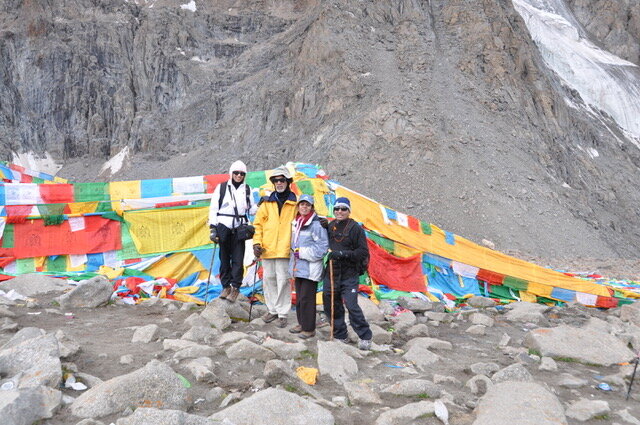Mountaineering
Mount Kailash, Tibet
“
Challenges make you discover things about yourself that you never really knew.
”
The Story (Part 1)
The Difficult Journey from Kathmandu, Nepal to Tibet and onwards to the Base Camp of Mount Kailash.
We started our overland trip in a bus from Kathmandu, Nepal. We crossed the Sino-Nepal Friendship Bridge to enter Tibet covering a distance of 683 miles (1,100 kilometers) by road, and onwards to the base camp of Mount Kailash.
“Although this distance appears insignificant, we traversed some of the loftiest, steepest, and most uncomfortable terrains in the world, a fact that was confirmed by our tour guide, and our own experiences with the abysmal roads and precipitous slopes.”
Once we entered Tibet, we were assigned into groups. Each group consisted of four people who would ride in a Toyota SUV to the base camp of Mount Kailash.
But driving to the base was not easy.
Our group of four people in a Toyota SUV.
We encountered several landslides on our drive. We passed over narrow stretches, deep potholes, sheer cliffs, and rocks in a cloud of dust, the SUV bumping, stomping, twisting and turning.
It was a roller coaster ride for six or seven days.
Through the harsh terrain with lots of ups and downs, we seemed to march forever till we reached one of the most beautiful lakes in the world …
Lake Manasarovar, the world’s highest freshwater lake.
The deep turquoise blue color of the lake.
The pristine and holy water of Lake Manasarovar was beckoning us to take a plunge. I felt a magnetic pull and was drawn in by its grandeur.
The water was awfully cold. But once I got into the lake, it didn’t bother me. The transcendent moments of pure joy overpowered the teeth-chattering joy of freezing cold water.
“A wave of calmness and peace washed over me that I had never experienced before. I was one with nature, healed, refreshed, and uplifted. ”
After the blissful pause at Lake Manasarovar, it was time to continue our journey and get to Darchen, the village at the southern foot of Mount Kailash, which stands at an elevation of 15,338 feet (4,675 meters), and serves as the starting point for the actual pilgrimage to Mount Kailash.
The Story (Part 2)
The Formidable Excursion from Darchen to Dolma La Pass, the highest permissible point of the journey to Mount Kailash.
From Darchen we had to undertake the yatra (pilgrimage) on foot, a pony, or yak.
Out of the group of thirty people, only four of us decided to do the entire three-day pilgrimage on foot.
This included my friend and I, and two women from London who were much younger than us.
“The three-day pilgrimage that involved walking around the thirty-two-mile (fifty-two-kilometer) circumference of Mount Kailash is referred to as parikrama by Hindus, Buddhists, and Jains, and the Kora by Böns (Tibetans).”
The Hindus, Buddhist, and Jains do the parikrama clockwise while the Böns do it counterclockwise.
On the first day of our three-day journey, we worked our way up Chaktsal Gang to Drirapuk Gompa (17,093 feet or 5,210 meters).
The second day was the toughest part of the pilgrimage as we had to continue our uphill trekking to the highest pass, Dolma La Pass (18,471 feet or 5,560 meters) where a big boulder on the pass that represents the Goddess Dolma (Dolma La is the Tibetan name of Goddess Parvati, wife of Lord Shiva) is festooned with prayer flags.
“The Dolma La Pass is the highest physical and spiritual point of the parikrama or kora. It is not allowed to go up any further to the summit of Mount Kailash itself.
”
While undertaking the formidable three-day peregrination, the only thing constant was continual walking, stopping only for tea, coffee or lunch, or camping for the night in a tent.
That’s Me … cold and exhausted.
It was freezing cold, and there were no showers or rest rooms. In fact we couldn’t shower or change our clothes during the seventy-two-hour expedition.
Yet we persevered as our intense drive and determination helped us stay motivated and focused to complete the parikrama.
“Once we got to the Dolma La Pass, I was teary-eyed and overjoyed all at once. Fellow yatris were congratulating each other, but I craved isolation.
”
I sat on a rock away from the crowd and felt for the first time what life would be like when you were devoid of material comforts and luxuries, and yet had this immense inner peace that can only be felt, but seldom described.
“I still get goose bumps thinking about circumambulating Mount Kailash, particularly completing the parikrama route at an elevation nearly 19,000 feet on foot. ”
1. Abode of Lord Shiva
Mount Kailash is hailed as the abode of Lord Shiva by Hindus. At the peak it rises to 22,028 feet (6,714 meters) and is a deeply venerated site for Hindus, Buddhists, Jains, and Böns (indigenous religion of Tibet).
Pilgrims from around the world go to this sacred mountain to circumambulate at about 19,000 feet.
In fact, climbing Mount Kailash is forbidden.
The only person to have ever climbed the holy mountain was Jetsun Milarepa, an eleventh century Tibetan Buddhist saint (yogi).
Within the Hindu trinity (this includes Lord Brahma and Vishnu), Lord Shiva is considered the destroyer of evil, and is also known as Yogeshvara or the Lord of Yoga
“The journey to Mount Kailash transformed me. Not only did I learn the meaning of acceptance, but also the importance of spending quality time with myself.”
2. Dolma La Pass
A year after my open-heart surgery, I climbed the Dolma La Pass of Mount Kailash in Tibet at 18,471 feet nearly 19,000 feet.
This is the highest permissible and spiritual point for pilgrims to ascend.
It is not allowed to go up any further to the summit of Mount Kailash itself, which stands at 22,028 feet due to its sacred status.
“People have died here because of altitude sickness. I didn’t know this then. ”
“I experienced unusual spiritual occurrences that I could not grasp through intellectual reasoning. It helped me from then on to live in the moment in peace, and to handle problems better.”
In the News - Heart of a Champion




